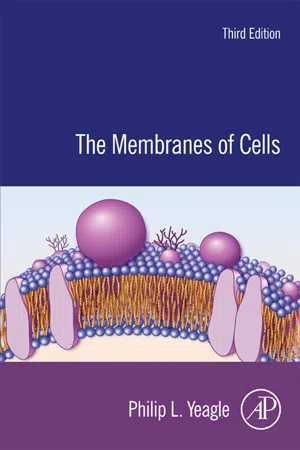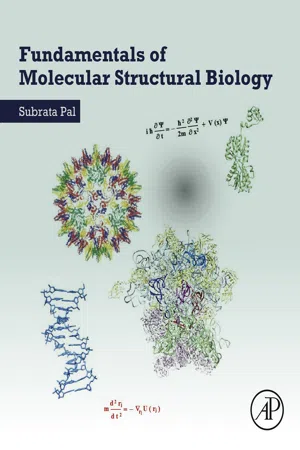Biological Sciences
Cell Membrane Structure
The cell membrane is composed of a phospholipid bilayer with embedded proteins, cholesterol, and carbohydrates. This structure provides a selectively permeable barrier that regulates the movement of substances in and out of the cell. The fluid mosaic model describes the dynamic nature of the cell membrane, with proteins and other molecules moving within the lipid bilayer.
Written by Perlego with AI-assistance
Related key terms
Related key terms
1 of 4
Related key terms
1 of 3
12 Key excerpts on "Cell Membrane Structure"
- eBook - ePub
The Physics of Living Processes
A Mesoscopic Approach
- Thomas Andrew Waigh(Author)
- 2014(Publication Date)
- Wiley(Publisher)
12 MembranesEvery living cell is surrounded by an outer membrane. The membrane acts as a dividing partition between the cell’s interior and exterior environments. It is the interface through which a cell communicates with the external world. Biological membranes are involved in a wide range of cellular activities. Simple mechanical functions occur using the membrane such as motility, food entrapment and transport. Also, highly specific biochemical processes are made possible by the membrane’s structure, which include energy transduction, nerve conduction and biosynthesis (Figure 12.1). Adhesion between cellular membranes is thought to be a critical factor for the determination of the morphology and the development of organisms (morphogenesis) from the initial ball of dividing cells (the blastula, Section 22.9 ).Schematic diagrams of (a) an animal and (b) a plant cell that show the compartmentalised structures and some individual pieces of intracellular machinery in two different types of eukaryotic cell.Figure 12.1[Copyright 2008 from Molecular Biology of the Cell, Fifth Edition by Alberts et al. Reproduced by permission of Garland Science/Taylor & Francis LLC.]Biological lipids in solution self-assemble into thin bilayer membranes that can compartmentalise different regions within a cell and protect the inside of the cell from the external environment. The membrane remains intact even when the bathing medium is extremely depleted of lipids due to the lipids’ extremely low critical micelle concentration (Section 8.1 ). Also, due to unsaturation and branching of the constituent lipids, the membranes are in a fluid state at physiological temperature, with rapid two-dimensional rearrangements possible of the neighbouring lipid molecules.Long-chained polypeptides are often embedded in membranes and consist of long strings of amino acid residues (~500 000). The polypeptides are rigid compared with the lipids in the surrounding cell membrane and they are amphiphilic, with their surface exposed to both hydrophobic and hydrophilic regions. These membrane proteins induce stress in the surrounding lipids, change the membrane’s curvature, and determine a range of functions that include adhesion and signalling. - No longer available |Learn more
MCAT Biochemistry Review 2024-2025
Online + Book
- (Author)
- 2023(Publication Date)
- Kaplan Test Prep(Publisher)
CHAPTER 8BIOLOGICAL MEMBRANES
In This Chapter
8.1 Fluid Mosaic Model General Membrane Structure and Function Membrane Dynamics8.2 Membrane ComponentsLipids Proteins Carbohydrates Membrane Receptors Cell–Cell Junctions8.3 Membrane TransportConcentration Gradients Passive Transport Active Transport Endocytosis and Exocytosis 8.4 Specialized Membranes Membrane Potential Mitochondrial MembranesConcept SummaryCHAPTER PROFILE
The content in this chapter should be relevant to about 10% of all questions about biochemistry on the MCAT. This chapter covers material from the following AAMC content categories:2A: Assemblies of molecules, cells, and groups of cells within single cellular and multicellular organisms3A: Structure and functions of the nervous and endocrine systems, and ways in which these systems coordinate the organ systemsIntroduction
Biological membranes are a stunning combination of opposites and contrasts. They are exceptionally thin, structurally bland, and relatively straightforward to describe. Yet, they define the borders of cells, tissues, and organelles; carry out a significant number of the biological functions within cells; and are an unending source of scientific inquiry and discovery. The most commonly tested biological membrane on the MCAT is the plasma membrane. At first, the plasma membrane seems like it’s only a shell—just a barrier that defines the cell. But the plasma membrane plays roles in signaling, entry of nutrients and expulsion of waste, cell recognition, transport of materials between tissues, and even electronic functions.Cell membranes have both a stretchy, flexible component (phospholipids) and an abundance of stabilizing molecules (cholesterol and protein) to make sure that everything remains intact. In this chapter, we will examine the general function, composition, and transport properties of biological membranes. We will conclude by taking a look at a few specialized cell membranes within the body, in addition to specific membrane properties. - eBook - ePub
- Philip L. Yeagle(Author)
- 2016(Publication Date)
- Academic Press(Publisher)
Chapter 1Introduction
Abstract
This chapter begins the exploration of the structure and function of biological membranes. Membranes are amazing structures. They are not a covalent whole like an individual protein, yet they exhibit stable structures. Membranes are not gene products and their most ubiquitous component, lipids, are not gene products. Yet they play roles in gene expression and may have been essential for the first genetic operations promoted by DNA. Biological membranes surround prokaryotes, both bacteria and archaebacteria, and constitute some of their internal structure. Membranes surround, define the outer limits of, and constitute much of the internal structure of, eukaryotes. Membranes surround and define the outer limits of enveloped viruses. As such, the most fundamental property of the biological membrane is to separate the inside from the outside of the biological entity. The hydrophobic effect determines the interaction between hydrocarbons and water (or lack thereof). The hydrophobic effect drives the lipids, based on their amphipathic chemical structure, to form lipid bilayers, the fundamental architecture of all biological membranes.Keywords
Hydrophobic effect; lipid bilayer; compartmentalization; cell structure; bacteria; archaebacteria; prokaryotes; virusesThe study of the membranes of cells is the study of the most fundamental structures that enable the function and stabilize the structure of cells (and enveloped viruses). Essential to the development of life forms as we know them is the compartmentalization of functions that we identify as cellular functions, separating them and protecting them from the milieu in which the life form is found. A promembrane (in the early stages of the genesis of life on earth) constricts what became the molecules of life inside a compartment to a region of relatively close contact, enhancing probability of chemical reactions. This compartmentalization opened the opportunity for a different chemistry inside the compartment than outside the compartment. The origins of biology as we know it today arguably began with the formation of such a promembrane. Thus the development of a simple membrane that defines an inside and an outside of a compartment and that protects and concentrates molecules in a space in which self-replication could evolve was essential to life. Membranes must therefore be at the core of basic requirements for the evolution of the first life forms. As will be seen in this book, even the complex cell membranes we know today are built of components that have a remarkable capability of spontaneous self-assembly. The chemical requirements for formation of membranes from individual molecules are relatively simple. Certainly the membrane lipids, which have dominated biology for much of the existence of biological cells, do form suitable promembranes spontaneously in water and achieve the properties described above. Other amphipathic molecules might also form promembranes if they have a suitably strong amphipathic chemical structure. Therefore in the evolution of primitive cells it is not difficult to imagine how the first cell membranes might have formed. - eBook - ePub
Drug-Biomembrane Interaction Studies
The Application of Calorimetric Techniques
- Rosario Pignatello(Author)
- 2013(Publication Date)
- Woodhead Publishing(Publisher)
All living cells, prokaryotic and eukaryotic, possess a thin cell or plasma membrane (also known as plasmalemma), which encloses their contents and acts as a semi-porous barrier to the outside environment. It also serves as the communications interface between the cell and its environment. Biological membranes also compartmentalize cellular organelles and their functions. Inside a cell, the endoplasmic reticulum, Golgi apparatus, lysosomes, vesicles and vacuoles are surrounded by a single biomembrane sheet. Mitochondria and the nucleus are surrounded by two membrane layers. Finally, the membrane regulates the flow of materials into and out of the cell, mediates intercellular communication, contacts and adhesion, and performs a multitude of other tasks.Various scientific hypotheses have been used to describe the structure of plasma membranes and Eichman wrote a good historical description.9 Of the various models, the most accepted theory is the fluid mosaic model, which was developed by Singer and Nicolson in 1972. According to this theory, a cell membrane consists of a continuous, fluid, double layer of phospholipid (PL), containing or attaching to in different ways other components like proteins, carbohydrates and cholesterol (CHOL) (see below). In a very simplified visualization, the PLs form a thin, flexible sheet, while the proteins float in this sheet like icebergs, and the carbohydrates protrude out from the surface (Figure 1.1 ).Figure 1.1 The fluid mosaic model of cell membranesThe name of this model arises from the assumption that the plasma membrane is not rigid, but exists in a fluid state where the different molecules are arranged like a mosaic pattern. The arrangement of these molecules is, however, not random, but regulated (in the physiological state) or dysregulated (in a disease state), which affects the coexistence, movement, trafficking and function of each component and of the entire membrane. Alterations to cell membrane dynamics and strength are often associated with disease. - eBook - ePub
- Subrata Pal(Author)
- 2019(Publication Date)
- Academic Press(Publisher)
Chapter 14Membrane structure and function
Abstract
Biomembranes consist of a hydrophobic matrix formed by a lipid bilayer with surface-bound and embedded proteins. The bilayer is both diverse and asymmetric in respect to its lipid composition. However, the amphipathic nature of all kinds of lipid molecules present in the membrane thermodynamically favors the formation of the common bilayer structure. Both lipids and proteins in the bilayer are in constant motion. As the boundary of a cell, the membrane displays a property of selective permeability, allowing only certain substances to be passively or actively transported across it. It also plays a crucial role in the cell’s response to environmental signals.Keywords
Biomembrane; Lipid bilayer; Membrane protein; Fluid mosaic model; Transport across membrane; Signal transductionIn order to sustain life, cells need to carry out a wide variety of chemical reactions. Earlier, we have discussed the synthesis of some of the most important biomolecules—DNA, RNA, and protein. However, we have to understand that the cell is able to synthesize its molecular constituents as well as carry out a number of other metabolic processes, efficiently and in an organized manner, since it is partially secluded from its more random environment by a biomembrane. The hydrophobic core of the membrane is formed by lipid assemblies.14.1 Composition of the membrane
In a living cell, lipids perform three general functions: (a) storage of energy as triglycerol ester and steryl esters, (b) as first and second messengers in signal transduction and molecular recognition processes, and (c) formation of the matrix of cellular membranes. It is the third function that we are concerned with in this chapter.Some bacterial cells (Gram-positive) contain just one membrane, whereas others (Gram-negative) are surrounded by two membranes—inner and outer. Eukaryotic cells are enclosed in a single plasma membrane. Some of the internal organelles of eukaryotic cells such as the nucleus, mitochondria, and chloroplasts are surrounded by double lipid bilayers, while endoplasmic reticula, Golgi apparatus, and lysosomes each contains a single lipid bilayer. Nevertheless, in all cases, lipids form the common core. Besides, the cell membranes also contain proteins and carbohydrates of different types and in varying amounts. - eBook - ePub
- Andrey B. Rubin(Author)
- 2017(Publication Date)
- Wiley-Scrivener(Publisher)
Chapter 12 Molecular Organization of Biological Membranes12.1 Composition and Structure of Biological Membranes
Biological membranes are functional cell structures with the thickness of several molecular layers enclosing the cytoplasm and most of intracellular structures and forming a uniform intracellular system of small channels, folds and closed cavities. The thickness of biological membranes is occasionally more than 10.0 nm, but due to a relatively tight packing of their basic molecular components (proteins and lipids), as well as large overall area of cell membranes as a rule, they make more than half of the dry cell mass.Biological membranes consist mostly of proteins, lipids and carbohydrates.Proteins and lipids make the most part of the mass of dry membranes. Usually, the portion of carbohydrates does not exceed 10–15 %, they being linked either to protein molecules (glycoproteins) or to lipid molecules (glycolipids). In membranes of different origin, the content of lipids varies from 25 to 75 % relative to protein mass (Table 12.1 ).Table 12.1. Content of Lipids in Mammalian Cell Membranes, % of the Mass of All LipidsLipids Plasma membranes Mitochondrii Lysosomes Nuclei Endoplasmic reticulum Golgi apparatus Phosphatidylcholine 18.5 37.5 23.0 44.0 48.0 24.5 Sphingomyelin 12.0 0 23.0 3.0 5.0 6.5 Phosphatidylethanolamine 11.5 28.5 12.5 16.5 19.0 9.0 Phosphatidylserine 7.0 0 6.0 3.5 4.0 2.5 Phosphatidylinositol 3.0 2.5 6.0 6.0 7.5 5.0 Lysophosphatidylcholine 2.5 0 0 1.0 1.5 3.0 Diphosphatidyl glycerol - eBook - ePub
- Britannica Educational Publishing, Kara Rogers(Authors)
- 2010(Publication Date)
- Britannica Educational Publishing(Publisher)
CHAPTER 2Cell Membranes and Cell WallsT he contents of all cells are enveloped by a highly specialized cell membrane. This membrane is a chemically complex structure and consists of multiple components, each of which contributes to the unique functions performed by the membrane. One of the most important of these functions is to serve as a protective layer, defending the cell interior against physical insult. In plants, a rigid cell wall reinforces this function, endowing stems, leaves, and roots with exceptional strength in the face of physical challenges ranging from wind to rain to sunlight.Contrasted against this physical role is the intricate regulatory nature of the membrane, which influences a variety of cellular activities, including the uptake of nutrients, cell-to-cell adhesion, and cell communication. Membrane-based regulatory capacity is made possible by the presence of diverse arrays of receptors and channels that recognize specific types of molecules, allowing them to enter and leave cells only under certain conditions, which are dictated by both intracellular and extracellular factors. This regulatory ability is one of the most complex and amazing features of cell membranes.THE CELL MEMBRANE
A thin membrane surrounds every living cell, delimiting the cell from the environment around it. Enclosed by this cell membrane (also known as the plasma membrane) are the cell’s constituents, often large, water-soluble, highly charged molecules such as proteins, nucleic acids, carbohydrates, and substances involved in cellular metabolism. Outside the cell, in the surrounding water-based environment, are ions, acids, and alkalis that are toxic to the cell, as well as nutrients that the cell must absorb in order to live and grow. The cell membrane, therefore, has two functions: first, to be a barrier keeping the constituents of the cell in and unwanted substances out and, second, to be a gate allowing transport into the cell of essential nutrients and movement from the cell of waste products. - eBook - ePub
- Caroline Bowsher, Alyson Tobin(Authors)
- 2021(Publication Date)
- Garland Science(Publisher)
Figure 3.1 ). These form crucial boundaries in all living systems. They separate internal spaces from the outside and permit the regulated movement of defined compounds across the membrane barrier. Differential staining shows that internal cell compartments, or organelles, are chemically different from one another, reflecting specialization for different biochemical activities. Here we will first consider the general structure and function of membranes and then turn our attention to the different organelle types.Membranes Consist of Lipids and Proteins Interacting with Water
Membrane structure depends on the interaction of lipid molecules with water. Membranes are composed of lipids and proteins. The lipids are organized into bilayers (two layers), whereas the protein polypeptide chains are embedded in the bilayer, sometimes protruding above the membrane surface on both sides of the membrane or lying predominantly in one or other of the two layers of lipid (Figure 3.2 ).Figure 3.2 Lipid bilayer model of cell membranes. Lipid molecules in the two layers have their hydrophilic heads on the outside of the membrane in contact with the water phase on each side of the membrane; their hydrophobic tails are directed to the inside of the membrane. Membrane proteins are shown spanning the entire width of the membrane, but some proteins can be restricted to either one of the two layers. (From Alberts et al., Molecular Biology of the Cell , 4th edition, New York, NY: Garland Science, 2002.)The organization of lipids and proteins in membranes is driven by the interaction of these molecules with water. In fact, the basic lipid bilayer structure can self-assemble in a test tube to form membrane-enclosed spaces called liposomes. However, in living organisms, all membranes are formed by the insertion of specific lipids into existing membranes.Lipids Are Amphipathic Molecules that Form Flat Sheets on a Water Surface
Most membrane lipids consist of fatty acid chains attached to a glycerol head. Glycerol is a three-carbon alcohol with a hydroxyl group on each carbon atom. The hydroxyl groups interact with the carboxylic acid at the end of the fatty acid molecules to form an ester (Figure 3.3 ). This type of lipid is termed a saponifiable lipid; when boiled with a strong alkali, free fatty acids are released (see Chapter 9 - eBook - ePub
Cell Boundaries
How Membranes and Their Proteins Work
- Stephen White, Gunnar von Heijne, Donald Engelman(Authors)
- 2021(Publication Date)
- Garland Science(Publisher)
2 Lipid Bilayers
DOI: 10.1201/9780429341328-3A key event in the emergence of the first living organisms was the evolution of lipid bilayers to separate the chemistry inside primitive cells from the environment, thus defining them as individual entities. We can only speculate about the nature of the earliest cell membranes, but given what we learned in Chapter 1 , they surely must have been composed of surface-active lipids. Whatever its evolutionary path may have been, the lipid bilayer as the organizing fabric of membranes has been extraordinarily successful. Besides providing the basis of Cell Membrane Structure, lipids participate in many other ways in life processes, such as energy storage and conversion, cellular communication, inflammatory responses, neuronal signal transmission, and carbohydrate metabolism. They are also involved in many disease states, including Alzheimer’s, asthma, cancer, malaria, and rheumatoid arthritis. The role of lipids in each of these diseases might be a long article, or even a book, so we confine our focus instead to the fundamental role of lipid structure in the formation and properties of lipid bilayers.The lipid bilayer, as we shall see, provides a formidable barrier to the movement of most water-soluble molecules. The task of selectively—and controllably—regulating the transbilayer movement of molecules and ions across membranes falls to membrane proteins. Because the proteins must function in the bilayer environment, our exploration of membrane proteins and membrane dynamics must begin with a close examination of lipids and the properties of lipid bilayers. There are many questions to answer. How does the molecular design of lipids lead to bilayer structures? How does membrane lipid composition affect membrane properties? How can we determine the structures of lipid bilayers? What characteristics of lipid bilayers do the structures reveal? What are the useful properties of bilayers that help cells live? By answering these and other questions, we will be able to appreciate in later chapters how the structures of membrane proteins meet the challenges of controlled movement of ions and other molecules across membranes. - eBook - ePub
- Anna Dee Fails, Christianne Magee(Authors)
- 2018(Publication Date)
- Wiley-Blackwell(Publisher)
stain may be used somewhat loosely, because the areas where the metals concentrate inhibit the passage of electrons, giving an electron‐dense appearance that shows up as a dark area in the final photographic print. After fixation, the tissue is dehydrated and infiltrated with plastic and embedded in plastic for sectioning. The sections are cut extremely thin (less than 30 nm), placed on a grid, and examined with the electron microscope.The picture of the typical cell (Fig. 2‐7 ) viewed with the electron microscope (see Fig. 1‐2 ) still shows most of the structures described by light microscopy but in much greater detail. The typical cell seen in light microscopy consists of a nucleus and cytoplasm surrounded by the cell membrane. The nucleus contains a nucleolus and chromatin material, which forms into chromosomes during cell division. A membrane called the nuclear envelope surrounds the nucleus. The cytoplasm contains a number of structures, or organelles, including the endoplasmic reticulum, Golgi apparatus, mitochondria, and inclusions.The general organization of a cell.Figure 2‐7.Source: adapted from Guyton and Hall, 2006. Reproduced with permission from Elsevier.The Cell Membrane
Structure of the Membrane
The outer cell membrane, also known as plasma membrane, and other membranes within the cell primarily consist of phospholipids, proteins, and cholesterol. According to the fluid mosaic model, the phospholipids are arranged with their polar (hydrophilic) ends facing the protein layers, while their nonpolar (hydrophobic) ends face each other in the center of the membrane (Fig. 2‐8 - eBook - ePub
Medicinal Chemistry
An Introduction
- Gareth Thomas(Author)
- 2011(Publication Date)
- Wiley(Publisher)
The primary function of the plasma membrane is to maintain the integrity of the cell in its environment. It is now also known that the membranes of all types of cell regulate the transfer of substances in and out of the cell and between its internal compartments. This movement controls the health, as well as the flow of information between and within cells. The plasma membrane of a cell is also involved in both the generation and receipt of chemical and electrical signals, cell adhesion, which is responsible for tissue formation, cell locomotion, biochemical reactions and cell reproduction. The internal cell membranes have similar functions and, in addition, are often actively involved in the function of organelles. Most drugs either interact with the receptors and enzymes attached to the membrane or have to pass through a membrane in order to reach their site of action.The role of membranes and cell walls in maintaining cell integrity and their involvement in cellular function makes these areas of cells potential targets for drug action. However, inFigure 7.1A diagrammatic representation of the structures of (a) animal and (b) plant eukaryote cells showing the principal cell organelles. These organelles can also have internal plasma membranes. (c) A diagrammatic representation of the structure of prokaryotic cells such as bacteria (see also Fig. 7.11 )order to design new and better drugs it is necessary to have a detailed picture of the structures of cell membranes and walls as well as a comprehensive knowledge of the chemistry of the biochemical processes that occur in these regions. This chapter attempts to give a broad picture of the current relevance of plasma membrane and cell wall structure to drug action and design.7.2 The plasma membraneThe currently accepted structure of membranes (Fig. 7.2 ), based on that originally proposed by S. J. Singer and G. L. Nicolson in 1972, is a fluid-like bilayer arrangement of phospholipids with proteins and other substances such as steroids and glycolipids either associated with its surface or embedded in it to varying degrees. This structure is an intermediate state between the true liquid and solid states, with the lipid and protein molecules having a limited degree of rotational and lateral movement.X-ray diffraction studies have shown that many naturally occurring membranes are about 5 nm thick. Experimental work has also shown that a potential difference exists across most membranes due to the movement of ions through ion channels (see section 7.2.2) and pumps in the membrane, the intracellular face of the membrane being the negative side of the membrane. For most membranes at rest, that is, not undergoing cellular stimulation, the potential difference (resting potential - eBook - ePub
Essentials of Chemical Biology
Structure and Dynamics of Biological Macromolecules
- Andrew D. Miller, Julian A. Tanner(Authors)
- 2013(Publication Date)
- Wiley(Publisher)
1 The Structures of Biological Macromolecules and Lipid Assemblies 1.1 General introduction All living organisms are comprised of cells that may vary considerably in terms of size, shape and appearance; in complex multicellular organisms, many cells are organised into diverse, functional organs to perform a collective function (Figure 1.1). In spite of their wide morphological diversity, all cells of all living organisms, wherever they are located, are comprised of proteins, carbohydrates, nucleic acids and lipid assemblies. These together give a cell form and function. To know and understand the chemistry of these biological macromolecules is to comprehend the basic infrastructure not only of a cell but also of living organisms. In functional terms, macromolecular lipid assemblies provide for compartmentalisation in the form of membrane barriers, which not only define the ‘outer limits’ of each cell but also divide up the intracellular environment into different organelles or functional zones (Figure 1.2). Membrane barriers are fluidic and lack rigidity, so proteins provide a supporting and scaffolding function not only in the main fluid bulk of the cell, known as the cytosol, but also within organelles. Within the nucleus, proteins also provide a nucleic acid packaging function in order to restrain and constrain spectacular quantities of nucleic acids within the nuclear volume. Everywhere in any cell, proteins also perform other individualised functions in outer membranes (as pores or receptors for example), in organelle membranes (as selective transporters, redox acceptors or energy transducers), in the cytosol or organelle volumes (as enzyme catalysts, molecular chaperones or ‘communication and control’ centres) and in the nucleus (as regulators and transcribers of the genetic code)
Index pages curate the most relevant extracts from our library of academic textbooks. They’ve been created using an in-house natural language model (NLM), each adding context and meaning to key research topics.
Explore more topic indexes
Explore more topic indexes
1 of 6
Explore more topic indexes
1 of 4











